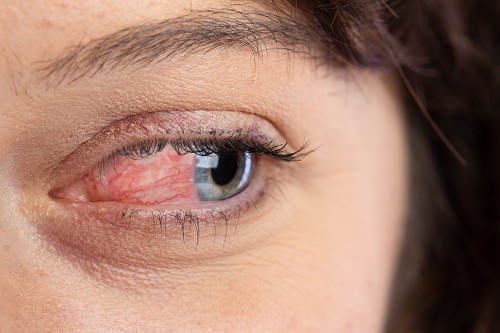
Approach to the Rosacea Patient
The patient presents for a full skin exam and the first thing you note when entering the room is how irritated the patient’s eyes appear. Both upper eyelids are erythematous with slight edema. Furthermore, the sclera of both eyes are blood shot. The remainder of the exam of the face is positive for scattered pustules and erythematous papules on the forehead and nose. Upon further questioning, the patient admits constant eye irritation, watering and burning. This is a typical presentation of ocular rosacea. Many patients with this condition are not aware they have a medical condition for which there are treatment options available.
Patients who present with ocular rosacea may have additional skin findings or may only present with ocular findings. Self-care for patients who present with ocular rosacea include warm compresses , sunglasses, moisturizing eye drops and eyelid scrubs. Prescription treatment for ocular rosacea can include prescription cyclosporine eye drops and many patients with ocular rosacea will need treatment with an oral antibiotic. Most of the time, the oral antibiotic that is prescribed for this condition is with sub-antimicrobial dosing. In other words, the antibiotic is dosed at a level lower than what is typically needed for an active bacterial infection.
The classic presentation of rosacea is a female in her 30s with Fitzpatrick Type 1 skin who complains of frequent “flushing” of the cheeks and nose. Rosacea is a chronic inflammatory condition for which there is no definitive cause. There does tend to be a genetic predisposition for the condition and patients with rosacea may have an abnormal vascular response to triggers, such as extreme temperatures. A reactive inflammatory response to a fungal or mite infection may also play a role in the condition.
Similar to acne, the type and severity of a patient’s rosacea dictates the treatment options for a patient. First line treatment of rosacea may include a topical antibiotic treatment. Additional topical medications include topical alpha blockers , azelaic acid, topical decongestants and antifungal medications. Lastly, some patients require an oral antibiotic for control of their facial rosacea, particularly in patients who have more acneiform lesions. Additional options for treatment include laser or intense pulsed light therapy.
When approaching a patient with rosacea, it is key to educate the patient about lifestyle choices that may exacerbate their condition. As rosacea presents with erythema due to dilation of the blood vessels, heat can worsen the condition. Heat can be in the form of exercise, or through the intake of spicy or foods at high temperatures. Additional triggers that may exacerbate a patient’s rosacea include red wine, caffeine and sun exposure.
Rhinophyma, is an unfortunate presentation with fibrosing of the skin of the nose and hyperplastic sebaceous glands. This condition is more common in men. Prevention of rhinophyma is key as once there is a remodeling of the skin of the nose, it can be more difficult to treat and typically requires surgical intervention.
Byline: Sarah B. W. Patton, PA-C, MSHS
Posted March 4, 2020
©2019







